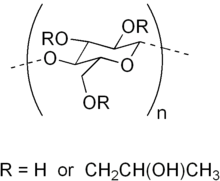Hydroxypropyl cellulose(HPC) is a derivative ofcellulosewith both water solubility and organic solubility. It is used as anexcipient,and topical ophthalmic protectant and lubricant.

| |
| Names | |
|---|---|
| Other names
Cellulose, 2-hydroxypropyl ether; oxypropylated cellulose; E463; hyprolose
| |
| Identifiers | |
| ChEMBL | |
| ChemSpider |
|
| DrugBank | |
| ECHA InfoCard | 100.116.338 |
| E number | E463(thickeners,...) |
| UNII | |
CompTox Dashboard(EPA)
|
|
| Properties | |
| variable | |
| Molar mass | variable |
Except where otherwise noted, data are given for materials in theirstandard state(at 25 °C [77 °F], 100 kPa).
| |
Chemistry
editHPC is anetherof cellulose in which some of thehydroxyl groupsin the repeatingglucoseunits have been hydroxypropylated forming -OCH2CH(OH)CH3groups usingpropylene oxide.The average number of substituted hydroxyl groups perglucoseunit is referred to as the degree of substitution (DS). Complete substitution would provide a DS of 3. Because the hydroxypropyl group added contains a hydroxyl group, this can also be etherified during preparation of HPC. When this occurs, the number of moles of hydroxypropyl groups per glucose ring, moles of substitution (MS), can be higher than 3.
Because cellulose is very crystalline, HPC must have an MS about 4 in order to reach a good solubility in water. HPC has a combination ofhydrophobicandhydrophilicgroups, so it has alower critical solution temperature(LCST) at 45 °C. At temperatures below the LCST, HPC is readily soluble in water; above the LCST, HPC is not soluble.
HPC formsliquid crystalsand manymesophasesaccording to its concentration in water. Such mesophases includeisotropic,anisotropic,nematicandcholesteric.The last one gives many colors such as violet, green and red.[1]
Uses
editLacrisert, manufactured by Aton Pharma, is a formulation of HPC used for artificialtears.It is used to treat medical conditions characterized by insufficient tear production such askeratoconjunctivitis sicca), recurrentcorneal erosions,decreased corneal sensitivity, exposure and neuroparalytickeratitis.HPC is also used as a lubricant for artificialeyes.[2][3][4] HPC is used as athickener,a low level binder and as anemulsionstabiliserwithE numberE463. In pharmaceuticals it is used as abinder[5]in tablets.
HPC is used as a sieving matrix for DNA separations by capillary and microchip electrophoresis.[6]
HPC is used as a thickener, emulsifier, and stabilizer in cosmetic formulations such as shampoos, conditioners, and lotions.[7]
HPC is the main ingredient in Cellugel, which is used in book conservation. Cellugel is described as "A safe, penetrating consolidant for leather book covers affected by red rot" and is produced by Preservation Solutions.[8]
See also
editNotes and references
edit- ^Barty-King, Charles; Chan, Chun Lam Clement; Parker, Richard; Bay, Mélanie; Vadrucci, Roberto; De Volder, Michael; Vignolini, Silvia (29 July 2021)."Mechanochromic, Structurally Colored, and Edible Hydrogels Prepared from Hydroxypropyl Cellulose and Gelatin".Advanced Materials.33(37): 2102112.Bibcode:2021AdM....3302112B.doi:10.1002/adma.202102112.PMID34323315.S2CID236497081.
- ^Luchs J, Nelinson D, Macy J (December 2010). "Efficacy of hydroxypropyl cellulose inserts (LACRISERT®) in subsets of patients with dry eye syndrome (DES): Findings from a patient registry".Cornea.29(12): 1417–1427.doi:10.1097/ICO.0b013e3181e3f05b.PMID20847657.S2CID40120861.
- ^McDonald M; D’Aversa G; Perry D; Wittpenn J; Nelinson D (Oct 2010). "Correlating patient-reported response to Hydroxypropyl cellulose ophthalmic insert (LACRISERT®) therapy with clinical outcomes: tools for predicting response".Curr Eye Res.35(10): 880–887.doi:10.3109/02713683.2010.495811.PMID20858108.S2CID207450381.
- ^Koffler B, McDonald M, Nelinson D (May 2010). "Improvement in clinical signs, symptoms, and QoL associated with DES: Hydroxypropyl Cellulose Ophthalmic Insert Patient Registry".Eye & Contact Lens.36(3): 170–176.doi:10.1097/ICL.0b013e3181db352f.PMID20351555.S2CID1751728.
- ^ Weiner, Myra L.; Lois A. Kotkoskie (1999).Excipient Toxicity and Safety.Taylor & Francis. p.8.ISBN978-0-8247-8210-8.
- ^Sanders, Joshua C.; Breadmore, Michael C.; Kwok, Yien C.; Horsman, Katie M.; Landers, James P. (February 2003). "Hydroxypropyl Cellulose as an Adsorptive Coating Sieving Matrix for DNA Separations: Artificial Neural Network Optimization for Microchip Analysis".Analytical Chemistry.75(4): 986–994.doi:10.1021/ac020425z.PMID12622396.INIST14571070.
- ^"Hydroxypropyl Cellulose".kimachemical.Retrieved7 March2023.
- ^"Cellugel".Conservationresources.Retrieved2021-12-20.